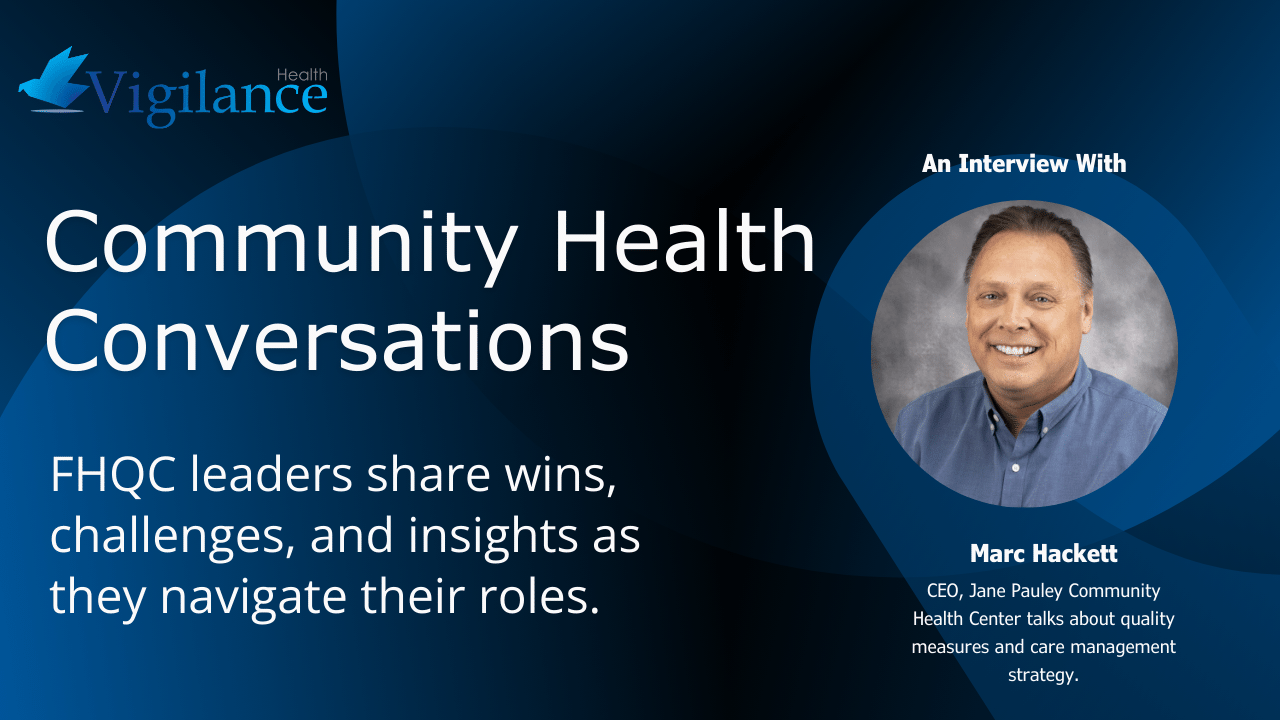
Two things we learned about Marc Hackett in our time together: he’s a NASCAR fan, and this would be his first official interview. His love of racing certainly makes sense as Marc hails from and lives in Indiana, home of the legendary Indy 500 and Indianapolis Motor Speedway. More surprising was that he was new to interviews. He was so easy to talk to and shared so many valuable insights from his 28 years of experience in the Community Health Center (CHC) world and now as the CEO of Jane Pauley Community Health Center.
In our interview, Marc tells us about his wins, challenges, and takeaways from implementing FQHC quality programs inside and beyond the center’s walls. We also dive into hot topics like chronic care management (CCM), the power of Health Care Navigators (HCNs), and the importance of working within the Medicare 65+ population. We’d say that’s pretty impressive for a first interview.
For some background, Marc joined Jane Pauley Community Health Center (JPCHC) as CEO in 2009. The newly founded organization had one site, serving 4,000 patients a year. Today, they are a recognized Federally Qualified Health Center (FQHC) and Patient-Centered Medical Home (PCMH) with ten sites and over 100,000 annual patient visits. It’s been a time of impressive growth but also rapid change, with a focus on partnerships with state hospital networks and health systems like the Indianapolis-based Community Health Network.
During this time of expansion, Jane Pauley’s leadership team never wavered in their commitment to providing high-quality patient care. They kept care management and quality improvement strategies in mind and constantly looked for ways to improve patient experience and outcomes. Even when faced with shortages of staff, funding, and resources, they continued to find innovative ways to improve the quality of care they delivered.
Hi, Marc! So nice to have you. Let’s start with a little background on Jane Pauley Community Health Center, that’s a pretty famous name.
Jane Pauley, or JP, as we call it, is central Indiana’s trusted nonprofit provider of affordable primary, behavioral, and dental health services. We’re an FQHC with 10 locations and over 250 staff, providing high-quality care regardless of coverage or ability to pay. Our patient population is about 65 percent Medicaid, 5 percent Medicare, 10 percent uninsured, and 20 percent privately insured.
Our name, of course, comes from Emmy-winning TV news personality Jane Pauley. She’s done so many things: The Today Show, Dateline, and now she hosts CBS Sunday Morning. She was born in Indianapolis, Indiana, a fifth-generation Hoosier, and graduated from Indiana University. She also went to Warren Central High School, just a short walk from our offices.
Jane Pauley lends us her name to care for her hometown. As a longtime children’s and mental health spokesperson, she’s been vocal in sharing her journey with late-diagnosed bipolar. She’s done a lot to remove stigmas around mental health, taking medications, and getting the care you need. She’s an exceptional person in our state and for our center.
There’s been some pretty impressive growth at Jane Pauley. How do you manage that while keeping an eye on quality?
Patient experience and quality of care are part of everything we do. We are always looking for ways to close Gaps in Care (GIC) to improve our care management programs and, ultimately, our quality outcomes. Whether on a staff level or a new technology for EHRs, we want to constantly beef up our internal quality measures.
One resource that we could not do without is our amazing Community Resource Navigators (CRNs). Huge shout out to our team!! They are the direct ties to our community and make a huge difference every day. Anyone can make an appointment with a CRN at our center, whether they are patients or not. The HCN helps with access to coverage, care, and other resources. They help sign people up for Medicaid on the spot and help them set up payment plans or apply the sliding fee scale. We’re fortunate to have certified State Health Insurance Assistance Program (SHIP) navigators on our team. They are versed in Medicare and can help with access to state coverage or even dual eligibility.
What’s a unique way you’re working to improve outcomes?
Well, here in Indiana, we have an abundance of county fairs. I love a good fair, and being at the booth is always a great time. Fair food is fun, but this is a great chance to educate the community about nutrition or other health resources. However, our primary goal is to get people to schedule an HCN appointment. Let them know we are here, care is available, and we can help them with that process at no cost.
When I’m at one of these community outreach events, I always make it a point to speak with any of our patients. I want to know about their experiences with us, both positive and negative. It’s a great way to get to the heart of the issue and see what needs to be fixed. As we know from our board of directors, community members, especially patients, offer the most significant insights.
We love to share FQHC wins. Tell us about a care management achievement you are proud of.
While not specific to Indiana, we do struggle with tobacco use, consistently ranking in the country’s top 10. It’s a top priority and a big thorn in the side of every healthcare executive in the state.
I’m specifically proud of a hypertension grant that Jane Pauley received. We worked to enroll over 1,100 patients in a hypertension/ high blood pressure improvement program, including free self-monitoring kits. The data collected flowed directly into our Epic EHR system. The program was very successful, with participants showing improved numbers and better overall control of their conditions.
Talk to us about adding Chronic Care Management to your strategy.
Like many community health centers, JPHC is navigating our way through Chronic Care Management (CCM): non-face-to-face care coordination services for Medicare’s sickest beneficiaries—those with two or more chronic conditions. It’s a small percentage of our population, maybe 5%, so it can sometimes, I admit, fall to the side. Most health centers are structured that way. I’m honestly not sure why, and with the massive baby boomer generation growing older, we knew we needed to change that.
Two things brought CCM to the forefront for me. The first was hearing a 65+ Medicare patient with multiple chronic conditions say, “You are the best-kept secret in town.” While it was a great compliment, we don’t want to be a secret. We want to be a resource and point of access for everyone in our community regardless of their coverage, Medicare, Medicaid, no coverage, private insurers. Especially with the exploding numbers of the 65+ population and their often more complex needs, we want people to know we are here and ready to serve them.
The second thing was meeting up with Vigilance at the NACHC CHI Conference in Orlando. They had prepared a Population Health Strategy Report for us, showing how they could help us with that 65+ population. It really enticed me because what they’re offering is something we’d like to do ourselves, but we don’t have the staff, time, or resources to do population health for that Medicare population.
Vigilance takes that extra step for us, conversing with patients and saying, ” Hey, I noticed you didn’t get your flu shot; why not? Can I schedule your appointment for that? Or I see you were in the office last week, and the provider gave you instructions. Are you following them? If not, let’s discuss why you’re not and see if we can rectify that. The model intrigued me, and when I brought this proposal back to our team, the leadership all agreed it was a worthwhile endeavor.
Why are Chronic Care Management and similar programs becoming so important?
The 65+ age group is growing, that’s first and foremost. It just makes good sense to be prepared for demographic changes in your community. As people age, they may use the health system more, or maybe they should be but aren’t. They may require a bit more time with an advocate or help navigating complex care directives.
We want people to know they can bring in all that overwhelming Medicare paperwork. Just gather it all up, stuff it in a bag, and bring it in. Our team will help you navigate the process and understand your choices for free, whether you are a patient or not. It’s a valuable resource, and we want people to know we’re here.
Many people also don’t realize that Medicare waives the $200 deductible for patients who go to FQHCs. Eliminating that fee removes one more obstacle to care. When Vigilance helps patients with this type of education, that helps us improve adherence and, ultimately, quality of care.
What is the biggest hurdle for an FQHC looking to implement a Chronic Care Management program?
The only thing holding you back is you! The good news is there aren’t many upfront costs involved; eventually, you can bill for these services, creating downstream revenue. Again, this is what caught my eye with Vigilance. It’s kind of like “found revenue” that you didn’t have before.
OK, that sounds very appealing. So what will you do with all this ‘Found Revenue’?
We’re big into education. We partner with a large family practice residency program through the Community Health Network. They have 30 residents. It’s a 10/10/10 model, so they graduate ten each year and bring in ten new each year. The residents rotate through one of our sites for their pediatric and OBGYN experience. FQHCs serve the neediest of the needy, and it’s an essential training experience for these providers. We hope to partner with them even more as we continue to grow.
Another goal is to start a family nurse practitioner program. I think these programs would benefit any community health center. There’s a provider shortage, and we must consider new ways to handle the unique, growing, and complex needs of FQHC patients and other vulnerable populations.
The provider shortage is especially prevalent in behavioral health, one of our fastest-growing service lines, and near and dear to the Jane Pauley mission. Coming out of COVID, we find that 70% of patients who come in for a primary care visit also deal with at least one behavioral health issue. There’s such a need for that type of care. We’ve hired over 40 behavioral health clinicians and could use 40 more. That’s another critical model we’re focusing on.
Do you have any community events scheduled for the New Year? We’d love to share!
We’ll be back on the County Fair circuit for sure. But over the winter months, we’ll definitely increase our community outreach around flu and other vaccinations. We can also help connect people to important resources like shelters and heating assistance.
Marc, it’s been a pleasure speaking with you. Thank you for sharing your experiences. There are so many valuable takeaways for other FQHC leaders considering care management strategies. Again, it’s hard to believe it was your first interview; you did an excellent job. Do you have any last thoughts you’d like to offer?
Providing the best possible care is the core of the FQHC mission. Everything we do should orbit around that goal. It’s never easy, and it’s ok to consider outside help. Do whatever it takes to make it happen. As we like to say at Jane Pauley, “If we see 400 patients today, that’s 400 chances to change somebody’s life. Let’s make sure it’s in a positive way.”

